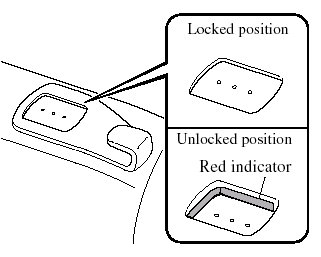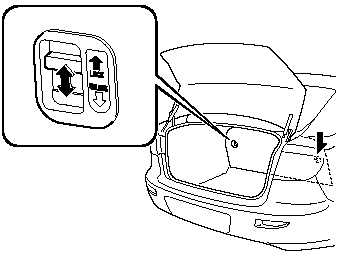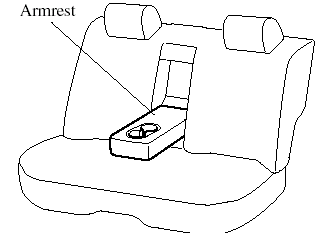Rear Seat
WARNING:
Do not stack cargo higher than the
seatbacks or place articles on the rear
package tray or on the luggage
compartment cover:
Stacking luggage or other cargo
higher than the seatbacks, and
placing articles on the rear package
tray or on the luggage compartment
cover is dangerous. During sudden
braking or a collision, objects can fly
around and become projectiles that
may hit and injure passengers.
Make sure luggage and cargo is
secured before driving:
Not securing cargo while driving is
dangerous as it could move or be
crushed during sudden braking or a
collision and cause injury.
Make sure the adjustable components of a seat are locked in place: Adjustable seats that are not securely locked are dangerous. In a sudden stop or collision, the seat or seatback could move, causing injury.
Do not drive with the seatback
unlocked:
All of the seatbacks play an
important role in your protection in a
vehicle. Leaving the seatback
unlocked is dangerous as it can allow
passengers to be ejected or thrown
around and baggage to strike
occupants in a sudden stop or
collision, resulting in severe injury.
After returning the seatback at any time, even when there are no other passengers, rock the seatback to make sure it is locked in place.
Never allow a passenger to sit or stand
on the folded seatback while the
vehicle is moving:
Driving with a passenger on the
folded seatback is dangerous.
Allowing a child to sit up on the folded seatback while the vehicle is moving is particularly dangerous. In a sudden stop or even a minor collision, a child not in a proper seat or child-restraint system and seat belt could be thrown forward, back or even out of the vehicle resulting in serious injuries or death. The child in the baggage area could be thrown into other occupants and cause serious injury.
Never give the car keys to children and
do not allow them to play in the
vehicle:
Playing with the folding rear seats is
dangerous. The folding rear
seatbacks cannot be folded down
from inside the trunk. Once the
seatbacks are back up, a child in the
trunk would not be able to get out
the way they had entered. If you have
small children, keep the seatbacks
locked (sedan).
Always leave your car locked and keep the car keys safely away from children: Leaving your car unlocked or the keys in reach of children is dangerous. Children who find their way into the trunk through an unlocked rear seatback or an open trunk can become accidentally locked in the trunk. This could result in death or brain damage from heat prostration, particularly in the summer. Always lock the doors and the trunk, and as an added measure, keep the rear seatbacks locked, whether you have children in your home or not.
Do not leave the key in your vehicle
with children and keep them in a place
where your children will not find or
play with them:
Leaving children in a vehicle with the
key is dangerous. This could result in
someone being badly injured or even
killed. Children may find these new
kinds of keys to be an interesting toy
to play with and could cause the
power windows or other controls to
operate, or even make the vehicle
move.
NOTE:
When returning a rear seat to its original
position, also replace the seat belt to its
normal position. Verify that the seat belt pulls
out and retracts.
Split-Folding Rear Seatback
To fold the seatbacks
CAUTION:
When operating the rear seatback
knob, make sure you support the
seatback with your hand. If the
seatback is not supported with your
hand, it will flip forward suddenly
and could cause injury to the finger
that pushes the rear seatback knob
down.
1. Unfasten the lap portion of the centerrear seat belt
CAUTION:
Always unfasten the lap portion of
the belt before folding the rear-left
seatback. Leaving the lap portion of
the belt fastened could cause
damage to the seat belt, buckle and
seatback.
2. Position the outboard seat belts to the side when folding the seatbacks down.
3. Support the seatback with your hand.

4. Push the rear seatback knob down.
To return the seatbacks to the upright position
1. Position the outboard seat belts to the side.
2. Lift the seatbacks upright.
3. Make sure the seat belts are fully pulled out from under the seatbacks.
4. Pull on the top of the seatbacks from inside the vehicle to make sure they are locked.
5. Fasten the center-rear lap/shoulder belt and check that all seat belts are routed properly for passenger use.
WARNING:
Always make sure the seat belts are
fully pulled out from under the
seatbacks:
A seat belt caught under a seatback
after the seatback is returned to its
upright position is dangerous. In a
collision or sudden stop, the seat belt
cannot provide adequate protection.
When returning the seatback to the
upright position, make sure there is no
red indication:
A rear seatback not fully returned
and locked in the upright position is
dangerous. Sudden stops or
maneuvering could cause a seatback
to flip forward suddenly resulting in
injury. If the red indicator is visible on
the back of the rear seatback knob,
the seatback is not locked in the
upright position.

Rear Seatback Lock (4 Door)

To lock or unlock a seatback, move the lever.
NOTE:
The seatback locks are part of the trunk
security system.
Armrest

The rear armrest in the center of the rear seatback can be used (no occupant in the center seat) or placed upright.
See also:
Interior Equipment (View C)
1 Windblocker.
2 Convertible top unlock lever.
3 Seat side box.
4 Remote fuel-filler lid release.
5 Back trim storage box.
6 Seat belt.
7 Seats.
8 Rearview mirror.
9 Interior light.
10 Sunv ...
Going & Stopping
All Mazda5s have a 2.3-liter four-cylinder engine that makes 153 horsepower
and 148 pounds-feet of torque. It's a smooth-revving unit that's strong enough
for its purposes, but it doesn't have a w ...
Fog Lights
Use this switch to turn on the fog lights.
They help you to see as well as to be seen.
To turn the fog lights on, rotate the fog
light switch to the position.
The headlight switch must be in th ...


